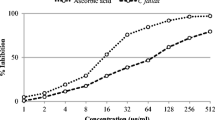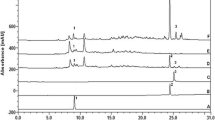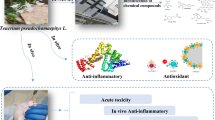Abstract
Amaranthus spinosus has been consumed traditionally to prevent various diseases including abdominal pain. In this study, the phytochemical composition, antioxidant and analgesic activities of an ethyl acetate extract of A. spinosus leaves (ASEA) were evaluated. The ASEA had the highest concentrations of total phenols (462.2 mg GAE/g DW), condensed tannin (5.01 mg CE/g DW) and total flavonoid contents (30.07 mg CE/g DW) compared to the chloroform, n-hexane, n-butanol and water extracts. Similarly, ASEA showed the most effective total antioxidant activity (45.45 µg/mL), DPPH scavenging activity (27.32 µg/mL) and hydrogen peroxide scavenging activity (30.60 µg/mL). ASEA with the doses of 200–600 mg/kg (p.o.) clearly demonstrated antinociceptive effects by reducing acetic acid-induced abdominal contortions with a maximal inhibition of 79.57% at 600 mg/kg and increasing latencies of the hot-plate paw-licking response. The tested doses also significantly (p < 0.001) decreased the reaction time in the formalin test at the neurogenic and inflammatory phases. ASEA contained ten polyphenols with caffeic acid being the predominant polyphenol. Overall, this study gave evidence that A. spinosus is a new antioxidant and analgesic agent, and justified its traditional use for the treatment of pain.





Similar content being viewed by others
References
Amin I, Norazaidah Y, Emmy Hainida KI (2006) Antioxidant activity and phenolic content of raw and blanched Amaranthus species. Food Chem 94:47–52
Bounatirou S, Smiti S, Miguel MG, Faleiro L, Rejeb MN, Neffati M, Pedro LG (2007) Chemical composition antioxidant and antibacterial activities of the essential oils isolated from Tunisian Thymus capitatus Hoff. et Link. Food Chem 105:146–155
Carocho M, Ferreira IC (2013) A review on antioxidants prooxidants and related controversy natural and synthetic compounds screening and analysis methodologies and future perspectives. Food Chem Toxicol 51:15–25
Coderre TJ, Vaccarino AL, Melzack R (1990) Central nervous system plasticity in the tonic pain response to subcutaneous formalin injection. Brain Res 535:155–158
Collier HOJ, Dinneen LC, Johnson CA, Schneider C (1968) The abdominal constriction response and its suppression by analgesic drugs in the mouse. Br J Pharmacol 32:295–310
Dewanto V, Wu X, Adom K, Liu RH (2002) Thermal processing enhances the nutritional value of tomatoes by increasing total antioxidant activity. J Agric Food Chem 50:3010–3014
Hlila MB, Mosbah H, Mssada K, Jannet HB, Aouni M, Selmi B (2015) Acetylcholinesterase inhibitory and antioxidant properties of roots extracts from the Tunisian Scabiosa arenaria Forssk. Ind Crop Prod 67:62–69
Huang B, Ke H, He J, Ban X, Zeng H, Wang Y (2011) Extracts of Halenia elliptica exhibit antioxidant properties in vitro and in vivo. Food Chem Toxicol 49:185–190
Hunskaar S, Hole K (1987) The formalin test in mice: dissociation between inflammatory and non-inflammatory pain. Pain 30:103–114
Ibrahim B, Sowemimo A, van Rooyen A, Van de Venter M (2012) Antiinflammatory analgesic and antioxidant activities of Cyathula prostrata (Linn.) Blume (Amaranthaceae). J Ethnopharmacol 141:282–289
Ishtiaq S, Ali T, Ahmad B, Anwar F, Afridi MSK, Shaheen H (2017) Phytochemical and biological evaluations of methanolic extract of Amaranthus graecizans subsp. silvestris (Vill.) Brenan. Br J Pharm Res 15:1–11
Jayaprakasam B, Zhang Y, Nair MG (2004) Tumor cell proliferation and cyclooxygenase enzyme inhibitory compounds in Amaranthus tricolor. J Agric Food Chem 52:6939–6943
Jayaprakasam B, Vanisree M, Zhang Y, Dewitt DL, Nair MG (2006) Impact of alkyl esters of caffeic and ferulic acids on tumor cell proliferation, cyclooxygenase enzyme, and lipid peroxidation. J Agric Food Chem 54:5375–5381
Joana Gil-Chávez G, Villa JA, Fernando Ayala-Zavala J, Basilio Heredia J, Sepulveda D, Yahia EM, González-Aguilar GA (2013) Technologies for extraction and production of bioactive compounds to be used as nutraceuticals and food ingredients an overview. Compreh Rev Food Sci Food Saf 12:5–23
Khoudja NK, Boulekbache-Makhlouf L, Madani K (2014) Antioxidant capacity of crude extracts and their solvent fractions of selected Algerian Lamiaceae. Ind Crop Prod 52:177–182
Kim HP, Son KH, Chang HW, Kang SS (2004) Anti-inflammatory plant flavonoids and cellular action mechanisms. J Pharmacol Sci 96:229–245
Kumar BSA, Lakshman K, Jayaveera KN, Shekar DS, Nandeesh R, Velmurugan C (2010) Chemoprotective and antioxidant activities of methanolic extract of Amaranthus spinosus leaves on paracetamol induced-liver damage in rats. Acta Med Salin 39:68–74
Liu J, Luo J, Ye H, Sun Y, Lu Z, Zeng X (2010) In vitro and in vivo antioxidant activity of exopolysaccharides from endophytic bacterium Paenibacillus polymyxa EJS-3. Carbohydr Polym 82:1278–1283
Mariod AA, Ibrahim RM, Ismail M, Ismail N (2009) Antioxidant activity and phenolic content of phenolic rich fractions obtained from black cumin (Nigella sativa) seedcake. Food Chem 116:306–312
Mehrotra A, Shanbhag R, Chamallamudi MR, Singh VP, Mudgal J (2011) Ameliorative effect of caffeic acid against inflammatory pain in rodents. Eur J Pharmacol 666:80–86
Miller T (1983) Protective effects of prostaglandins against gastric mucosal damage: current knowledge and proposed mechanisms. Ame J Physiol Gastrointest Liver Physiol 245:G601–G623
Naczk M, Shahidi F (2006) Phenolics in cereals fruits and vegetables occurrence extraction and analysis. J Pharm Biomed Anal 41:1523–1542
Nardini M, Leonardi F, Scaccini C, Virgili F (2001) Modulation of ceramide-induced NF-κB binding activity and apoptotic response by caffeic acid in U937 cells: comparison with other antioxidants. Free Rad Biol Med 30:722–733
Nwidu LL, Nwafor PA, Da Silva VC, Rodrigues CM, dos Santos LC, Vilegas W, Nunes-de-Souza RL (2011) Anti-nociceptive effects of Carpolobia lutea G. Don (Polygalaceae) leaf fractions in animal models. Inflammopharmacol 19:215–225
Okoli CO, Akah PA, Nwafor SV, Anisiobi AI, Ibegbunam IN, Erojikwe O (2007) Anti-inflammatory activity of hexane leaf extract of Aspilia africana CD Adams. J Ethnopharmacol 109:219–225
Prasad KN, Yang B, Yang S, Chen Y, Zhao M, Ashraf M, Jiang Y (2009) Identification of phenolic compounds and appraisal of antioxidant and antityrosinase activities from litchi (Litchi sinensis Sonn.) seeds. Food Chem 116:1–7
Rjeibi I, Saad AB, Hfaiedh N (2016) Oxidative damage and hepatotoxicity associated with deltamethrin in rats: the protective effects of Amaranthus spinosus seed extract. Biomed Pharmacother 84:853–860
Schmauss C, Yaksh TL (1984) In vivo studies on spinal opiate receptor systems mediating antinociception. II. Pharmacological profiles suggesting a differential association of mu delta and kappa receptors with visceral chemical and cutaneous thermal stimuli in the rat. J Pharmacol Exp Ther 228:1–12
Sun B, Ricardo-da-Silva JM, Spranger I (1998) Critical factors of vanillin assay for catechins and proanthocyanidins. J Agric Food Chem 46:4267–4274
Tanmoy G, Arijit M, Tanushree S, Jagadish S, Kumar MT (2014) Pharmacological actions and phytoconstituents of Amaranthus spinosus Linn a review. Intern J Pharmacogn Phytochem Res 6:405–413
Tlili N, Elfalleh W, Hannachi H, Yahia Y, Khaldi A, Ferchichi A, Nasri N (2013) Screening of natural antioxidants from selected medicinal plants. Int J Food Prop 16:1117–1126
Vaz ZR, Mata LV, Calixto JB (1997) Analgesic effect of the herbal medicine catuama in thermal and chemical models of nociception in mice. Phytother Res 11:101–110
Wheeler-Aceto H, Porreca F, Cowan A (1990) The rat paw formalin test: comparison of noxious agents. Pain 40:229–238
Xu Y, Lin D, Yu X, Xie X, Wang L, Lian L, Huang X (2016) The antinociceptive effects of ferulic acid on neuropathic pain: involvement of descending monoaminergic system and opioid receptors. Oncotarget 7:20455–20468
Ye Küpeli E, Silada E (2007) Flavonoids with anti-inflammatory and antinociceptive activity from Cistus laurifolius L. leaves through bioassay-guided procedures. J Ethnopharmacol 112:524–530
Ymele EV, Dongmo AB, Dimo T (2013) Analgesic and anti-inflammatory effect of aqueous extract of the stem bark of Allanblackia gabonensis (Guttiferae). Inflammopharmacol 21:21–30
Zeashan H, Amresh G, Singh S, Rao CV (2008) Hepatoprotective activity of Amaranthus spinosus in experimental animals. Food Chem Toxicol 46:3417–3421
Zeashan H, Amresh G, Rao CV, Singh S (2009) Antinociceptive activity of Amaranthus spinosus in experimental animals. J Ethnopharmacol 122:492–496
Acknowledgements
The authors express their gratitude to the Ministry of Higher Education and Scientific Research.
Funding
The authors did not get any fund from any organization for this study.
Author information
Authors and Affiliations
Contributions
IR conducted the experiments and wrote the draft. ABS conducted data analysis and contributed to the writing of the manuscript. JS and AF contributed substantially to the writing of the manuscript. SN participated in experimental design and provided reagents. MSA revised the pharmacological part of the manuscript. NH participated in the direction of all the experimental parts of the manuscript. SS has provided direction during the current investigation and has contributed to the writing of the manuscript. All authors edited, read and approved the final manuscript.
Corresponding author
Ethics declarations
Conflict of interest
Authors have declared no conflicts of interest.
Electronic supplementary material
Below is the link to the electronic supplementary material.
Rights and permissions
About this article
Cite this article
Rjeibi, I., Ben Saad, A., Sdayria, J. et al. HPLC–DAD identification of polyphenols from ethyl acetate extract of Amaranthus spinosus leaves and determination of their antioxidant and antinociceptive effects. Inflammopharmacol 27, 975–984 (2019). https://doi.org/10.1007/s10787-018-0482-0
Received:
Accepted:
Published:
Issue Date:
DOI: https://doi.org/10.1007/s10787-018-0482-0




